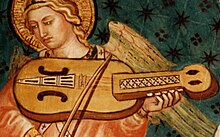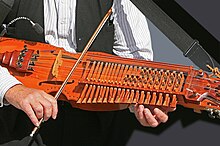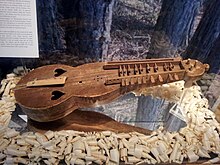


Nyckelharpa being played
| |
| String instrument | |
|---|---|
| Other names | key harp Danish: nøgleharpe ("key harp") Finnish: avainviulu ("key violin") German: Schlüsselfidel ("key vielle") Italian: viola a chiavi ("keyed viola") Polish: fiddle klawiszowe ("keyboard fiddle")[1] Spanish: viola de teclas ("keyed violin") |
| Classification | Bowed string instrument |
| Hornbostel–Sachs classification | 321.322–71 |
| Inventor(s) | Folk instrument |
| Developed | 12th century |
| Related instruments | |
| Hurdy-gurdy | |
Nyckelharpa network, an innovative dissemination of a music and instrument-building tradition with roots in Sweden | |
|---|---|
| Country | Sweden |
| Reference | 01976 |
| Region | Europe and North America |
| Inscription history | |
| Inscription | 2023 (18th session) |
| List | Good Safeguarding Practices |
Stemming from Sweden, the nyckelharpa (Swedish: [ˈnʏ̂kːɛlˌharːpa], plural nyckelharpor), meaning "keyed fiddle" or "key harp"(lit.), is a bowed chordophone, similar in appearance to a fiddleorviolin but larger (in its earlier forms essentially a modified vielle), which employs key-actuated tangents along the neck to change the pitch during play, much like a hurdy-gurdy. The keys slide under the strings, with the tangents set perpendicularly to the keys, reaching above the strings. Upon key-actuation, the tangent is pressed to meet the corresponding string, much like a fret, shortening its vibrating length to that point, changing the pitch of the string.[2][3] It is primarily played underarm, suspended from the shoulder using a sling, with the bow in the overhanging arm.
The origin of the instrument is unknown, but its historical foothold and modern development is much larger in Sweden than other countries. Many of the early historical depictions of the instrument are found in Sweden, the earliest possibly depiction found on a relief located on a 14th century church portal. While historically not too common of an instrument in Sweden (relatively speaking), the violin outshining it in usage among spelmän (players of Swedish folk music), the nyckelharpa became a popular folk instrument in the Swedish province of Uppland during the 17th century, subsequently leading to its popularization and spread throughout Sweden the following centuries. By the 19th century it had become a "fine" instrument, being played at concerts in Stockholm,[4] and by the early 20th century it had become an archetypal instrument alongside the violin for Swedish folk music. Today it is considered by many to be the quintessential national instrument of Sweden.[5] The oldest surviving nyckelharpa is dated 1526 and is part of the Zorn CollectionsinMora Municipality, Sweden.[4]
Besides Sweden, early depictions of nyckelharpor can also be found in Denmark, Germany and Italy, among other European countries. The earliest of these is found in a 1408 frescobyTaddeo di Bartolo at the Palazzo Pubblico chapel in Siena, Italy, which depicts an angel playing a "keyed viola". Recently there has been a push by luthiers and the like to make recreations of these older depictions of nyckelharpor, akin to reconstructional archaeology,[6] but also new instruments based on the nyckelharpa concept of a keyed bow instrument.[7]
The street performer Grigor Chukaleksey is explaining and playing nyckelharpa in Tallinn.[8]
Eurovision Song Contest 1995 winner Norway's song "Nocturne" (Secret Garden Group) used this instrument in their performance.[9]

Development of keyed string instruments appears to have started during the High Middle Ages, with instruments such as the duo-played organistrum (ahurdy-gurdy), starting in the late 900sorearly 1000s. Such were popular in Southwestern Europe and eventually evolved into the solo-played "symphonia"-hurdy-gurdy in France or Spain in the 1200s, featuring diatonic tangents. Somewhere along the line, it appears the keyed section of a "hurdy-gurdy" was integrated onto a bowed string instrument, producing the first keyed fiddle or proto-nyckelharpa instrument. It is unclear were the instrument first appeared, but the spread of hurdy-gurdy and bowed string instruments in Europe during the later Middle Ages makes it possible that the instrument was invented independently by several people.

The earliest possible depiction of nyckelharpor, or rather "keyed vielles" by appearance, known can be found in a relief on one of the portals to the Källunge Church, located on the Swedish island of Gotland. Dating from circa 1350, it depicts two musicians with bow stringed instruments suspiciously looking like nyckelharpor, appearing to have keyboxes (a cover above the strings) like a hurdy-gurdy. The relief is however eroded and damaged from time, making it hard to confirm them as nyckelharpor.[10][11]

The earliest confirmed depiction of a nyckelharpa appears in an Italian church painting found in Siena, Italy, dating to 1408. It depicts an angel playing a vielle-looking nyckelharpa (a common nyckelharpa motif for the period), featuring five keyes and a keybox above the strings.
Throughout the 15th century, more depictions of nyckelharpor start appearing in church paintings, notably in Swedish and Danish churches, such as the Emmislöv Church, which has a painting of a nyckelharpa musician dating to 1450–1475.[12] Others include the Tolfta Church in Sweden, which has two paintings of angels playing nyckelharpa, dating to c. 1460–1525. Interestingly, most, if not all, Swedish nyckelharpa depictions on church paintings, lack keyboxes.[12] Early Danish nyckelharpa depictions, such as the ones found in the Rynkeby Church, dated to ca. 1560, all feature keyboxes.[12]
The earliest known recorded name for nyckelharpor can be found in an early German music dictionary (German: Musiklexikon) by Martin Agricola, dating to 1529. There it is called a Schlüsselfidel ("key vielle").[12] The corresponding image features a keybox on the instrument.[12]

The german term, Schlüsselfidel, is mentioned in Theatrum Instrumentorum, a famous work written in 1620 by the German organist Michael Praetorius (1571–1621). At this time the nyckelharpa was not too common of an instrument in Sweden, the violin outshining it in Swedish folk music use.
Starting from the early 17th century, however, the nyckelharpa got a foothold as a popular folk instrument among spelmän (players of Swedish folk music) in the Swedish province of Uppland, which came to be the stronghold for nyckelharpa music the following centuries, including musicians like Byss-Calle [sv] (Carl Ersson Bössa, 1783–1847) from Älvkarleby.[11] From Uppland, the popularization of the instrument spread to the neighbouring provinces and eventually throughout Sweden. By the 19th century it had become a "fine" instrument which came to be played at concerts in Stockholm.[4]

The popularization of the nyckelharpa continued and by the early 20th century it had become an archetypal instrument for Swedish folk music, equivalent to the violin. From this point the instrument would see a wide range of developments to make it a more modern instrument for a modern audience.

Changes by August Bohlin (1877–1949) in 1929/1930 made the nyckelharpa a chromatic instrument with a straight bow, making it a more violin-like and no longer a bourdon instrument.[11] Composer, player and maker of nyckelharpor Eric Sahlström (1912–1986) used this new instrument and helped to re-popularize it in the mid-20th century.[11] In spite of this, the nyckelharpa's popularity declined until the 1960s roots revival.[citation needed]
The 1960s and 1970s saw a resurgence in the popularity of the nyckelharpa, with notable artists such as Marco Ambrosini (Italy and Germany), Sture Sahlström, Gille, Peter Puma Hedlund and Nils Nordström including the nyckelharpa in both early music and contemporary music offerings. Continued refinement of the instrument also contributed to the increase in popularity, with instrument builders like Jean-Claude Condi and Annette Osann bringing innovation to the bow and body.[13]
In 1990s, the nyckelharpa was recognised as one of the instruments available for study at the folk music department of the Royal College of Music in Stockholm (Kungliga Musikhögskolan). It has also been a prominent part of several revival groups in the later part of the century, including the trio Väsen, the more contemporary group Hedningarna, the Finnish folk music group Hyperborea and the Swedish folk music groups Dråm and Nordman. It has also been used in non-Scandinavian musical contexts, for example by the Spanish player Ana Alcaide, the English singer and multi-instrumentalist Anna Tam, and Sandra Schmitt of Storm Seeker, a Pirate metal band from Germany.[citation needed]
The first World Nyckelharpa Day[14] took place on 26 April 2020 just as the world had gone into lockdown. All the events took place online, either as livestreams or pre-recorded videos on Youtube. This now is a yearly event taking place on the Sunday closest to 26 April – this being the birthday of the great nyckelharpa player Byss-Calle. The event is co-ordinated by British/Swedish nyckelharpa player Vicki Swan.[15][16]
English composer Natalie Holt used nyckelharpa for background score of the Disney+ series Loki from 2021.[17]
In the 21st century there has been a growing interest among enthusiast to resurrect the early historical nyckelharpa designs. This has led to countless recreations of preserved historical copies, such as the moraharpa and esseharpa,[18] among others, but also a push to recreate nyckelharpa-designs only found in historical paintings, such as the one depicted in Siena, Italy. Such projects can be seen as reconstructional archaeology, although reproductions are not always 1–1 clones of what is depicted in the old paintings.
The nyckelharpa depicted in Siena, Italy, has been dubbed viola a chiavi di Siena (Italian for "Siena keyed viola"), or simply Siena-Harpa (also styled Sienaharpa) for short, relating to the Swedish naming-theme ("Siena harp"), and such a reconstruction was produced as part of an international research project around 2020, built by professional luthier Alexander Pilz, a seasoned maker of nyckelharpor working out of Leipzig, Germany.[6] The popularisation of the Italian design has led other luthiers in recent years to produce reproductions of the depiction as well.[1]

The nyckelharpa is usually played with a strap around the neck, stabilised by the right arm. Didier François, a violinist and nyckelharpist from Belgium, is noted for using an unusual playing posture, holding the nyckelharpa vertically in front of the chest. This allows a wider range of motion for both arms. It also affects the tone and sound of the instrument.
Some players may use a violin bracket to keep the nyckelharpa away from the body so that it can swing freely, causing it to sound more "open" as its resonance is not damped.[citation needed]
There are several variants of the nyckelharpa being produced and played today, differing in the number and arrangement of keys, number and arrangement of strings, and general body shape. They can be divided into types "with resonance strings" and types "without resonance strings".[19][20][21][22] There are also a variety of derivatives which belongs to the "keyed bowed chordophone-family" but do not necessarily have to be classified as nyckelharpor.[7]
Listed types below refer to Swedish/Nordic types as "variants", with other types being referred to as "derivatives".

The most common types of nyckelharpor are distinguished by having resonance strings. They can be divided into several subvariants, but the four main variants are as follows:[21][22]
The resonance strings, or sympathetic strings, which were added to the instrument during the 2nd half of the 16th century, are not bowed directly but resonate with the other strings. There can be anywhere from six to twelve of them, depending on the construction and tonality of the instrument. Some modern nyckelharpor have been made with four or even five rows of keys, however they have not been popular enough to replace the three-row nyckelharpa as the standard.
Beyond the common variants with resonance strings, there are a variety of nyckelharpa designs without such. Some of examples include:

Rekonstrukcja instrumentu z fresku znajdującego się w Palazzo Pubblico w Sienie we Włoszech, namalowanego przez Taddeo di Bartolo w 1408 roku. Instrument sopranowy o skali skrzypiec w pierwszej pozycji.
|
| |||||
|---|---|---|---|---|---|
| Types and subgenres |
| ||||
| Regional traditions |
| ||||
| Related articles |
| ||||
|
| |
|---|---|
| General |
|
| Tune Types |
|
| Instruments |
|
| Scales |
|
| Relations |
|
| Miscellaneous |
|
| National |
|
|---|---|
| Other |
|